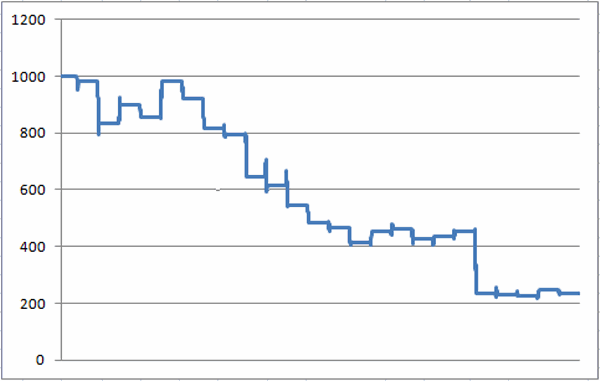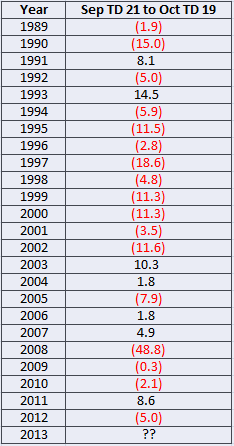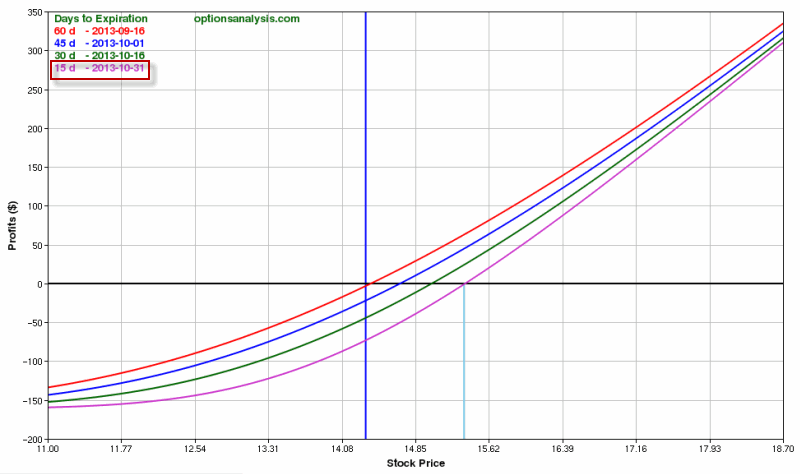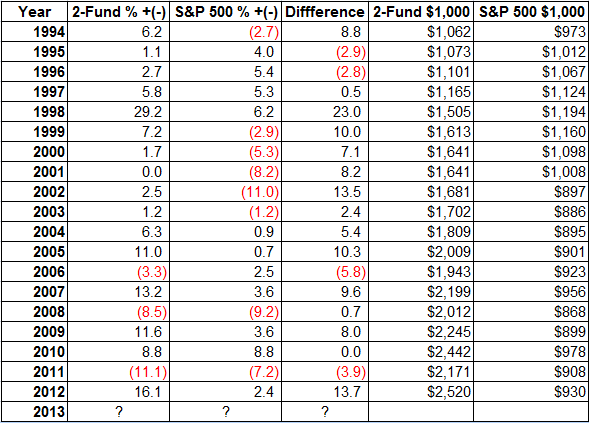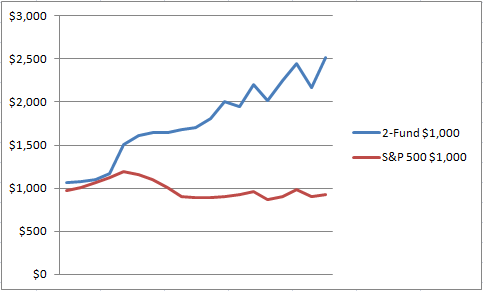Well that didn’t pan out. Gold stocks in September that is. At the end of August I wrote about the historical tendency for gold stocks to perform well during the month of September (For the record, I also highlighted the fact that monthly seasonal trends are always far from a “sure thing” and that there is never any guarantee that a particular seasonal trend will work out “this time around.” Hey, at least I got that part right).
Still, whenever you write about the historical tendency for a given stock/index/commodity/etc to move in a particular direction during a particular period you expect at least a little cooperation. Not this time.
With one trading day left in September gold stocks have proven to be just about the worst place you could have been during September 2013. As I write both tickers FSAGX and GDX are both down over 10% for the month. Ouch.
So should I issue an apology, and blather on about “where my analysis broke down” and “what I should have done differently” and so on? Maybe, but in reality a seasonal trend by itself is nothing more than a play on the odds. Sometimes it works out, sometimes it doesn’t. Fortunately, I have been around the markets long enough to know that, well to paraphrase – “stuff happens.” Which I think is fairly succinctly captured in:
Jay’s Trading Maxim #20: The markets don’t always do what you want them to do. Deal with it.
I have also been around long enough to know that it is your own responsibility to make sure that things that go completely and utterly and entirely the wrong way are not allowed to do too much damage to your trading account. So when it comes to potential trades based on seasonal trends (and come to think of it, just about any other trading method), the two questions to ask are:
1. Am I going to take the trade?
2. How much capital will I allocate?
Allocating capital, i.e., “money management”, is one of those “boring” topics that makes everyone’s eyes glaze over. Which is a shame given that it is one of the most critically important pieces of business for any trader or investor to take care.
For example, consider again gold stocks in the month of September. If a trader had allocated 20% of his or her trading capital to gold stocks in the last month, they would have lost about 2% of their account. Not good obviously, but also not exactly catastrophic. Now consider the trader who decided to “roll the dice” and “bet the ranch” and “go for the gusto” and [your euphemism here] and put 100% of his or her trading capital into gold stocks. That trader just lost 10% in a month. Ouch.
Now as a sidebar and for the record, a 10% down month does not qualify as “catastrophic.” It certainly qualifies for “Wow, that really sucks” status, but anyone who survived September/October of 2008 can at least acknowledge the fact that these things can be overcome in the long run. Thus and ironically, the even bigger danger of a -10%+ month is the potential psychological damage that can affect your thinking the next time around (“Wow, I don’t want to experience that again, therefore, maybe I’ll just sit out the next trade – or 10.” Also typically known as “the trades that would have made you whole.”)
So all of this leads to a few more key takeaways:
Jay’s Trading Maxim #48: Your biggest enemy in the markets are unexpected events. Your 2nd biggest enemy is you. Control the enemy you can and allocate capital wisely to control the enemy you cannot.
Jay’s Trading Maxim #108: He who “bets the ranch” so to speak, invariably ends up “renting a small apartment” – so to speak.
OK, so you get the idea. That all being cleared up – but with the painfully wrong result in September still at top of mind – it’s time to talk about gold stocks in the month of October. Gulp.
Gold Stocks in the Month of October
So here we go again. At the moment gold stocks are dirt cheap relative to the price of gold bullion (and have been for some time) and gold stocks are extremely oversold (granted they have been “oversold” for about nine months now), so it seems that gold stocks are long overdue for a sharp bounce to higher ground. So given the potential for a sharp rally at any time and the spectacularly wrong result during the month of September, I am somewhat hesitant to point out the long-term historical performance of gold stocks during the month of October. But hey, the show must go on.
Figure 1 displays the, um, growth(?) of $1,000 invested in Fidelity Select Gold fund (ticker FSAGX) from the end of September through the 19th trading day of October starting in October 1988.
Figure 1 – Growth of $1,000 invested in FSAGX from end of September through October Trading Day 19 (1989-2012)
Figure 2 displays the year-by-year % gain/loss achieved by ticker FSAGX during the first 19 trading days of October
Figure 2 – Year-by-Year FSAGX results from end of September through October Trading Day 19 (1989-2012)
For the record:
-Net loss: (-76.5%)
-# of times UP: 7 (29%)
-# of times DOWN: 17 (71%)
-Average % +/- all years (-4.9%)
-Average % gain during 7 UP years: +7.1%
-Average % loss during 17 down years: (-9.8%)
Summary
So are gold stocks destined to decline between the end of September and the close on October 25th (the 19th trading day of October 2013)? Didn’t we learn anything this past month? Nothing is guaranteed in the financial markets, especially when it comes to seasonal trends. All we know for sure is that over the past 24 years this period has witnessed a decline in gold stocks 71% of time.
This leads us right back to the two questions I posed earlier:
1. Am I going to take the trade? (more on this in the next post)
2. How much capital will I allocate?
Same as it ever was.
Jay Kaeppel
